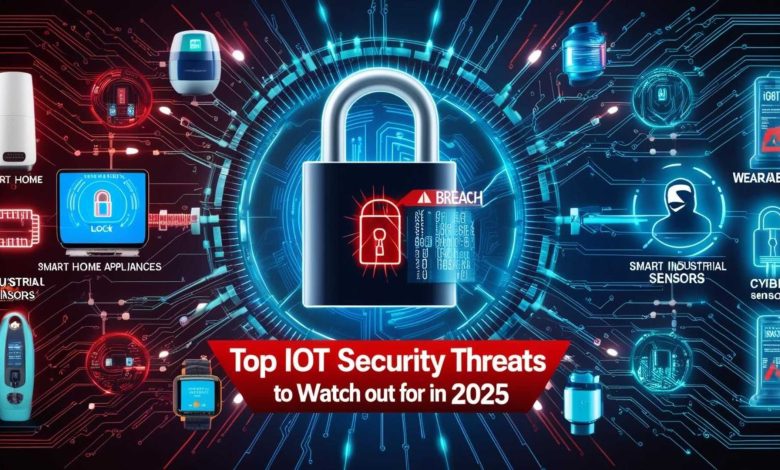Top IoT Security Threats to Watch Out for in 2025

The Internet of Things (IoT) is rapidly transforming how we live, work, and interact with technology. However, as more devices connect to the internet, the risk of IoT security threats increases. In 2025, organizations and individuals need to be aware of evolving IoT security threats to protect their data, privacy, and infrastructure. This article will highlight the most critical IoT security risks to watch out for and how to mitigate them.
Understanding IoT Security Threats: Why It Matters
IoT devices, ranging from smart home gadgets to industrial sensors, are designed to enhance convenience and efficiency. However, these connected devices often become targets for cybercriminals due to their vulnerabilities. With 5G networks expanding and more industries adopting IoT solutions, the landscape of IoT security threats will only grow. It’s crucial to understand these threats and take proactive measures to secure IoT networks.
1. Device Hacking: The Gateway to Other Security Breaches
One of the most common IoT security threats is device hacking. Cybercriminals can exploit vulnerabilities in connected devices, such as cameras, wearables, or smart appliances, to gain unauthorized access to networks. Once inside, attackers can steal sensitive data, monitor activities, or even disrupt operations.
Key Prevention Strategies:
- Regularly update device firmware
- Use strong passwords and encryption
- Employ multi-factor authentication (MFA)
2. Insecure Communication Channels
Many IoT devices communicate with each other through unsecured channels, making them vulnerable to interception. Hackers can listen in on these communications, potentially altering the data being transmitted or injecting malicious code. This type of vulnerability is particularly dangerous in sectors like healthcare or finance, where sensitive information is exchanged.
Mitigation Measures:
- Implement end-to-end encryption for all communications
- Use Virtual Private Networks (VPNs) to secure data transmission
- Regularly audit IoT devices for communication vulnerabilities
3. Botnet Attacks and DDoS Exploits
A growing threat in the IoT world is the rise of botnets. Cybercriminals often hijack vulnerable IoT devices to form a botnet—a network of compromised devices used to launch Distributed Denial of Service (DDoS) attacks. These attacks can overwhelm systems, causing downtime and disrupting services.
Protective Actions:
- Ensure IoT devices are securely configured and regularly updated
- Use firewalls and Intrusion Detection Systems (IDS) to monitor unusual traffic
- Segregate IoT devices on a separate network from critical systems
4. Lack of Standardized Security Protocols
As the IoT ecosystem continues to expand, the lack of consistent security standards poses a significant risk. Different manufacturers use different security protocols, making it difficult to ensure that all devices in an IoT network are adequately secured. This lack of uniformity increases the potential for breaches.
How to Overcome This Issue:
- Advocate for the adoption of universal security standards across the IoT industry
- Prioritize security compliance when selecting IoT devices for integration
- Stay informed on the latest IoT security certifications
5. Privacy Violations and Data Harvesting
Many IoT devices collect a significant amount of personal and sensitive data. Unfortunately, if not properly secured, this data can be intercepted or harvested by malicious actors. For example, hackers might gain access to smart home devices, such as voice assistants, to listen in on conversations or gather personal information for identity theft.
Best Practices to Secure Privacy:
- Use data anonymization techniques for sensitive information
- Regularly review privacy policies and permissions for IoT devices
- Set up alerts for unusual activities on IoT devices
6. Ransomware Targeting IoT Devices
Ransomware attacks are becoming increasingly prevalent, with cybercriminals targeting IoT devices to hold them hostage. By infecting a vulnerable IoT device, attackers can lock it and demand a ransom for its release. This can result in significant financial losses and operational disruptions.
Counteracting Ransomware:
- Regularly back up IoT device data
- Employ comprehensive cybersecurity software with ransomware protection
- Educate employees and users about phishing and suspicious activity
7. Insider Threats
Sometimes, the biggest threat to IoT security comes from within the organization. Employees, contractors, or service providers who have access to IoT systems can exploit their privileges for malicious purposes, either intentionally or unintentionally. Insider threats are particularly hard to detect because the perpetrators often have authorized access to systems.
Preventing Insider Threats:
- Implement strict access controls and monitor user behavior
- Conduct regular security awareness training for employees
- Use auditing tools to track activity on IoT devices and networks
How to Protect Your IoT Infrastructure in 2025
Protecting against IoT security threats requires a multi-layered approach. Here are some essential steps to safeguard your IoT infrastructure:
- Network Segmentation: Separate IoT devices from your main network to limit potential exposure.
- Security Awareness: Educate employees and users about the importance of IoT security.
- Automation: Use automated monitoring tools to track device behavior and detect potential threats in real time.
- Vendor Security: Ensure that IoT device manufacturers follow industry best practices for security.
FAQs About IoT Security Threats
Q1: What are the most common types of IoT security threats?
The most common IoT security threats include device hacking, insecure communication, botnet attacks, privacy violations, ransomware, and insider threats.
Q2: How can I protect my IoT devices at home?
You can protect your IoT devices by using strong passwords, enabling encryption, updating firmware regularly, and isolating IoT devices on a separate network.
Q3: Are there IoT security standards that I should follow?
While there is no universal standard, many industries have adopted guidelines such as the IoT Cybersecurity Improvement Act to ensure better security across IoT devices.



